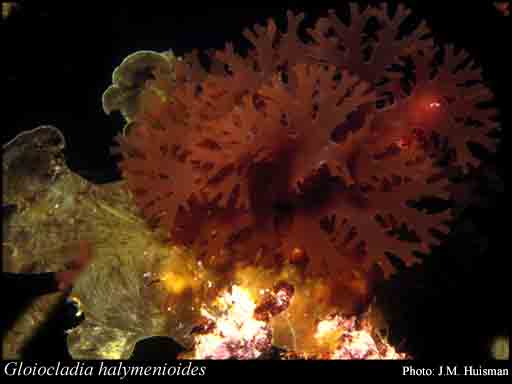- Reference
- Bot.Zeit. 55 (1845)
- Conservation Code
- Not threatened
- Naturalised Status
- Native to Western Australia
- Name Status
- Current

Scientific Description
Habit and structure. Thallus medium to dark red, fading to yellow-red or grey-red, mucilaginous and adhering to paper on drying, (10–)20–50(–75) cm high, complanately branched and usually bipinnate, often becoming tripinnate; axes 2–4(–6) cm broad, main laterals basally constricted, usually 1–2 cm broad and 1–2 mm thick, lesser laterals usually 2–4 cm long and 3–6 mm broad with ultimate ramuli (1–)2–6(–10) mm long, 1–2 mm broad, tapering to a point. Holdfast discoid, 2–5 mm across, with a thick cuneate stipe; epilithic. Structure of a cortex 80–200 µm thick with an outer cortex of anticlinal filaments soon becoming 80–120 µm and 4–8 cells long, branching at most cells, cells 2–4 µm in diameter, elongate, and an inner cortex of ovoid to angular cells 15–25 µm across, becoming only slightly stellate; medulla of moderate to dense irregular filaments 4–8(–10) µm in diameter, usually with prominent refractive ganglionic cells with large central bosses and long slender arms linking with arms of other such cells when young.
Reproduction. Sexual thalli probably dioecious. Carpogonial branch ampullae arising in inner cortex, with 4–8 secondary and tertiary filaments converging somewhat above, and a 2-celled carpogonial branch. Auxiliary cell ampullae arising in inner cortex, with numerous secondary and tertiary filaments forming a broad ampulla slightly converging above and reaching to the outer cortex, with a prominent auxiliary cell. Carposporophytes 180–220 µm across, lying within the medulla, with a dense mass of ovoid to angular carposporangia each 8–12 µm across; involucre moderate to dense, derived largely from ampullary filaments which branch further around the distinct ostiole. Spermatangia not observed. Tetrasporangia arising from mid cells of the outer cortex, elongate-ovoid, 30–40 µm long and 10–15 µm in diameter, cruciately divided, usually with prominent refractive ganglionic cells with large central bosses and long slender arms linking with arms of other such cells when young.
Distribution. Yanchep, W. Aust., to Walkerville, Vic., and the north coast of Tas.
[After Womersley, Mar. Benthic Fl. Southern Australia IIIA: 206–208 (1994)]
Distribution
- IBRA Regions
- Esperance Plains, Swan Coastal Plain.
- IBRA Subregions
- Perth, Recherche.
- IMCRA Regions
- Central West Coast, Leeuwin-Naturaliste, WA South Coast.
- Local Government Areas (LGAs)
- Cambridge, Cockburn, Coorow, Cottesloe, Dandaragan, Esperance, Joondalup, Mandurah, Rockingham, Wanneroo.